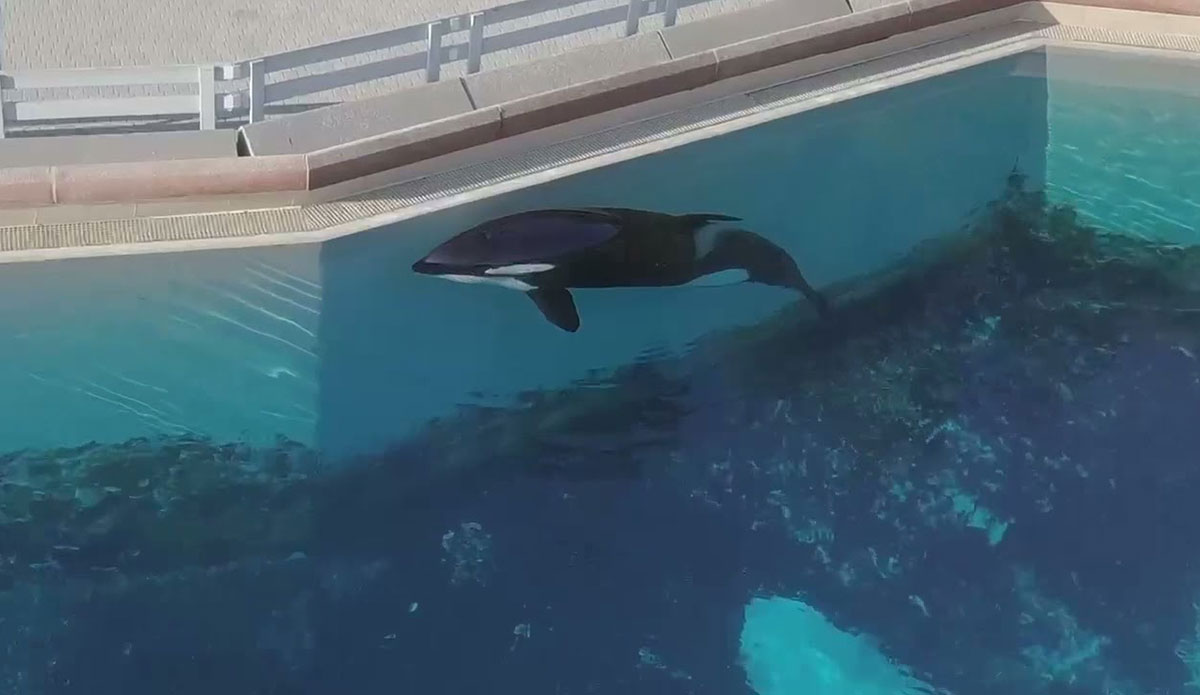
Kiska the world’s loneliest whale has died in a tank at MarineLand. She was thought to be 47 years old. Photo: Screenshot//YouTube
Kiska, the orca dubbed the “world’s loneliest whale,” has died. Her life was a tragic one, and her death could be seen as a sort of release. She was believed to be 47 years old, although her exact age isn’t positively known. She was the last captive killer whale in Canada.
In 1979, when Kiska was three years old, she was caught in Icelandic waters and taken to MarineLand, a theme park in Niagara Falls, Ontario, Canada. Kiska was captured along with Keiko, the whale made famous in the movie Free Willy, and for a few years in the ’80s, the pair shared a pool. Kiska spent 40 years there, swimming in a concrete tank.
For the last 12 years of her life, Kiska was alone in her tank. Orcas are social animals that live in tight-knit pods, hunting together and communicating with each other. Her tank at MarineLand was bare and featureless, and her depression was caught on film recently in a hard-to-watch video that went viral.
Kiska’s death was reportedly caused by a bacterial infection, four years after Canada passed bill S-203, which banned the catching or breeding of whales, dolphins and porpoises for captivity. The law, however, was too little too late for Kiska, as whales already in captivity were excluded from the protection it offered.
It’s generally believed that whales captured too young or whales born in captivity can’t be released into the wild. In the wild, young orcas spend years at their mother’s side, learning to hunt. They spend their whole lives in the same pod. And since a whale born in captivity and then taken from their mother has neither a mother or a pod, it never learns to properly hunt. It doesn’t have the same social skills as a wild whale. There are even some concerns that the whale “languages” might be different.
Her death has prompted renewed calls for global protection of marine mammals. For years, in fact, protesters have been trying to have her released into a sea pen, an area designated for captured whales that would at least give them some semblance of where they’re supposed to live. Kiska, though, wasn’t able to make it.
“When I heard that Kiska died, I just bawled, which I almost never do,” Camille Labchuk, executive director of the Toronto campaign group Animal Justice, told the CBC. “It’s frustrating for so many people because it felt like we were so close to being able to get her out and she just couldn’t hold on long enough.”
Keiko, the whale Kiska was captured with, was released back into Icelandic waters in 2002 after a Mexican entertainment park bought him. He was rehabilitated before being released, but died in a bay in Norway at the age of 27. It was just one year after he was released.
Kiska, though, stayed at MarineLand. She gave birth to five calves, all of which died. The last whale she lived with was Ikaika, son of Tilikum, the whale made famous by killing three people. Tilikum was the whale featured in Blackfish, the documentary that is partially responsible for the public’s interest in the welfare of captive whales.
In 2011, Ikaika was flown to California’s SeaWorld, and Kiska began her road to becoming the world’s loneliest whale. MarineLand has long been the focus of animal rights activists’ ire. The park has been accused of neglecting the animals they keep in captivity and keeping them in poor conditions. According to The Guardian, Ontario’s Provincial Animal Welfare Services has inspected MarineLand 160 times since January, 2020.
In a statement, MarineLand said its “marine mammal care team and experts did everything possible to support Kiska’s comfort and will mourn her loss.”
Although her life and death is tragic to say the least, we can at least hope that Kiska can be used as an example of how not to treat whales in the future.

